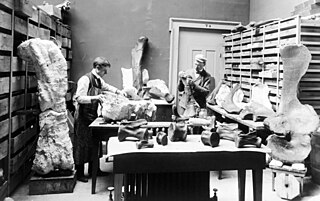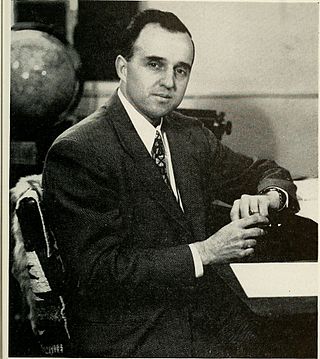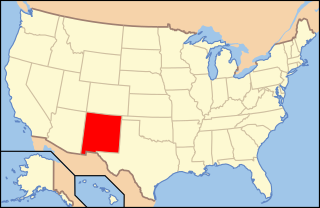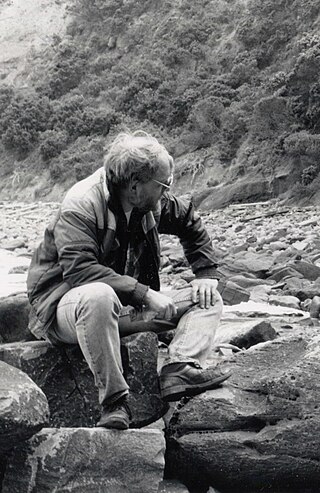Related Research Articles

The order Peramelemorphia includes the bandicoots and bilbies. All members of the order are endemic to Australia-New Guinea and most have the characteristic bandicoot shape:a plump,arch-backed body with a long,delicately tapering snout,very large upright ears,relatively long,thin legs,and a thin tail. Their size varies from about 140 grams up to 4 kilograms,but most species are about one kilogram.

Annie Montague Alexander was an explorer,naturalist,paleontological collector,and philanthropist.

William Diller Matthew FRS was a vertebrate paleontologist who worked primarily on mammal fossils,although he also published a few early papers on mineralogy,petrological geology,one on botany,one on trilobites,and he described Tetraceratops insignis,which was much later suggested to be the oldest known therapsid.

Dromornis is a genus of large to enormous prehistoric birds native to Australia during the Oligocene to Pliocene epochs. The species were flightless,possessing greatly reduced wing structures but with large legs,similar to the modern ostrich or emu. They were likely to have been predominantly,if not exclusively,herbivorous browsers. The male of the largest species,Dromornis stirtoni,is a contender for the tallest and heaviest bird,and possibly exhibited aggressive territorial behaviour. They belong to the family Dromornithidae,extinct flightless birds known as mihirungs.

The Alcoota Fossil Beds are an important paleontological Lagerstätte in the Northern Territory of Australia located on Alcoota Station in the locality of Anmatjere about 115 kilometres (71 mi) north-east of Alice Springs in the Central Australia region. It is notable for the occurrence of well-preserved,rare,Miocene vertebrate fossils,which provide evidence of the evolution of the Northern Territory’s fauna and climate. The Alcoota Fossil Beds are also significant as a research and teaching site for palaeontology students.

Palorchestes is an extinct genus of large terrestrial,herbivorous Australian marsupial of the family Palorchestidae,living from the Miocene through to the Late Pleistocene. Like other palorchestids,it had highly retracted nasal region suggesting that it had a prehensile lip,as well as highly unusual clawed forelimbs that were used to grasp vegetation.

The University of California Museum of Paleontology (UCMP) is a paleontology museum located on the campus of the University of California,Berkeley.
Stirton's deer mouse is a species of rodent in the family Cricetidae. It is found in El Salvador,Guatemala,Honduras,and Nicaragua. P. stirtoni is widely distributed and is presumed to have a large population and a tolerance of habitat destruction,though its biology is poorly understood. The species is named after Ruben A. Stirton (1901-1966),an American zoologist associated with the University of California at Berkeley.

Kolponomos is an extinct genus of carnivoran mammal that existed in the Late Arikareean North American Land Mammal Age,early Miocene epoch,about 20 million years ago. It was likely a marine mammal. The genus was erected in 1960 by Ruben A. Stirton,a paleontologist at the University of California Museum of Paleontology,Berkeley,for the species K. clallamensis,on the basis of a partial skull and jaw found on the Olympic Peninsula. At the time,Stirton questionably assigned it to Procyonidae,its systematic position remained problematic until the discovery of more fossils including a nearly complete cranium from the original locality of K. clallamensis which helped identify it as part of the group from which pinnipeds evolved.

Malcolm Carnegie McKenna (1930–2008) was an American paleontologist and author on the subject.

Elmer Samuel Riggs was an American paleontologist known for his work with the Field Museum of Natural History in Chicago,Illinois.

Frank Elmer Peabody,was an American palaeontologist noted for his research on fossil trackways and reptile and amphibian skeletal structure.

Edwin Harris "Ned" Colbert was a distinguished American vertebrate paleontologist and prolific researcher and author.
Claude William Hibbard,popularly known as Hibbie,was an American paleontologist.

Paleontology in New Mexico refers to paleontological research occurring within or conducted by people from the U.S. state of New Mexico. The fossil record of New Mexico is exceptionally complete and spans almost the entire stratigraphic column. More than 3,300 different kinds of fossil organisms have been found in the state. Of these more than 700 of these were new to science and more than 100 of those were type species for new genera. During the early Paleozoic,southern and western New Mexico were submerged by a warm shallow sea that would come to be home to creatures including brachiopods,bryozoans,cartilaginous fishes,corals,graptolites,nautiloids,placoderms,and trilobites. During the Ordovician the state was home to algal reefs up to 300 feet high. During the Carboniferous,a richly vegetated island chain emerged from the local sea. Coral reefs formed in the state's seas while terrestrial regions of the state dried and were home to sand dunes. Local wildlife included Edaphosaurus,Ophiacodon,and Sphenacodon.

James Lloyd Patton,is an American evolutionary biologist and mammalogist. He is emeritus professor of integrative biology and curator of mammals at the Museum of Vertebrate Zoology,UC Berkeley and has made extensive contributions to the systematics and biogeography of several vertebrate taxa,especially small mammals.
Ngapakaldia is an extinct genus of diprotodontid marsupials,related to the modern koala and wombat. Around the size of a sheep,it was a ground-dwelling herbivore that lived around the vegetated shores of lakes in Central Australia during the Late Oligocene.

Fossil Lake is a dry lakebed in the remote high desert country of northern Lake County in the U.S. state of Oregon. During the Pleistocene epoch,Fossil Lake and the surrounding basin were covered by an ancient lake. Numerous animals used the lake's resources. Over time,the remains of many of these animals became fossilized in the lake sediments. As a result,Fossil Lake has been an important site for fossil collection and scientific study for well over a century. Over the years,paleontologists have found the fossil remains of numerous mammals as well as bird and fish species there. Some of these fossils are 2 million years old.

Miocochilius is an extinct genus of small notoungulate mammals (typotheres) native to South America. The genus lived during the Middle Miocene epoch. The genus contains two described species,the type species M. anomopodus described in 1953 by Ruben Arthur Stirton and M. federicoi,described and included in the genus by Darin A. Croft.

Thomas Rich,generally known as Tom Rich,is an Australian palaeontologist. He and his wife,Patricia Arlene Vickers-Rich headed the dig at Dinosaur Cove. He is,as of 2019,Senior Curator of Vertebrate Palaeontology at Museums Victoria.
References
- 1 2 "GRIN - Dromornis". www.grin.com (in German). Retrieved 2019-05-15.
- 1 2 3 4 Gregory, Joseph T. (May 1997). "Ruben A. Stirton (1901-1966)". UCMP History.
- ↑ Stirton, R. A.; Tedford, Richard H.; Woodburne, Michael O. (1967). "A new Tertiary formation and fauna from the Tirari Desert, South Australia". Records of the South Australian Museum. 15 (3): 427–462.
- ↑ "University of California: In Memoriam, June 1967". texts.cdlib.org. Retrieved 2022-07-01.